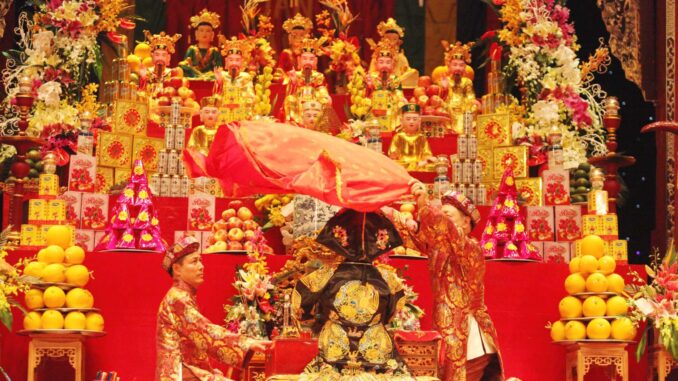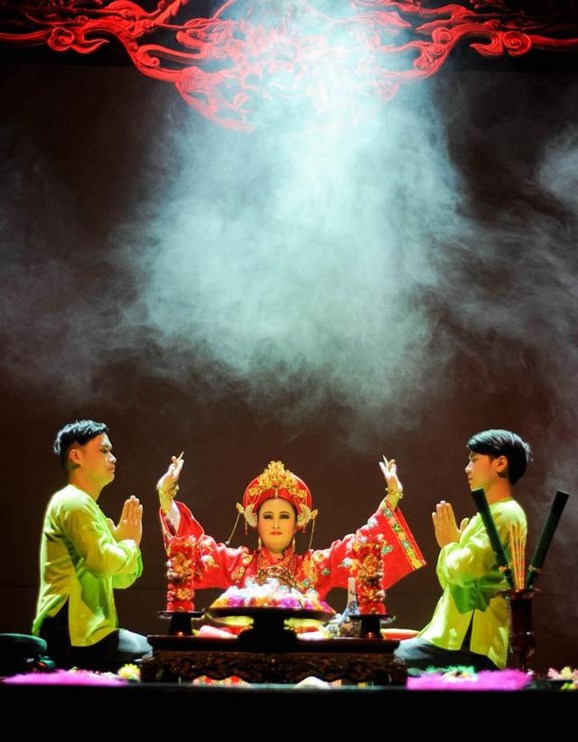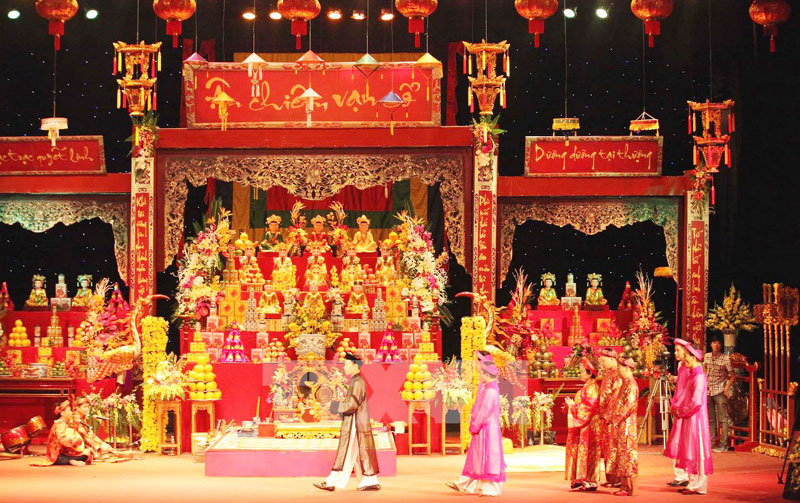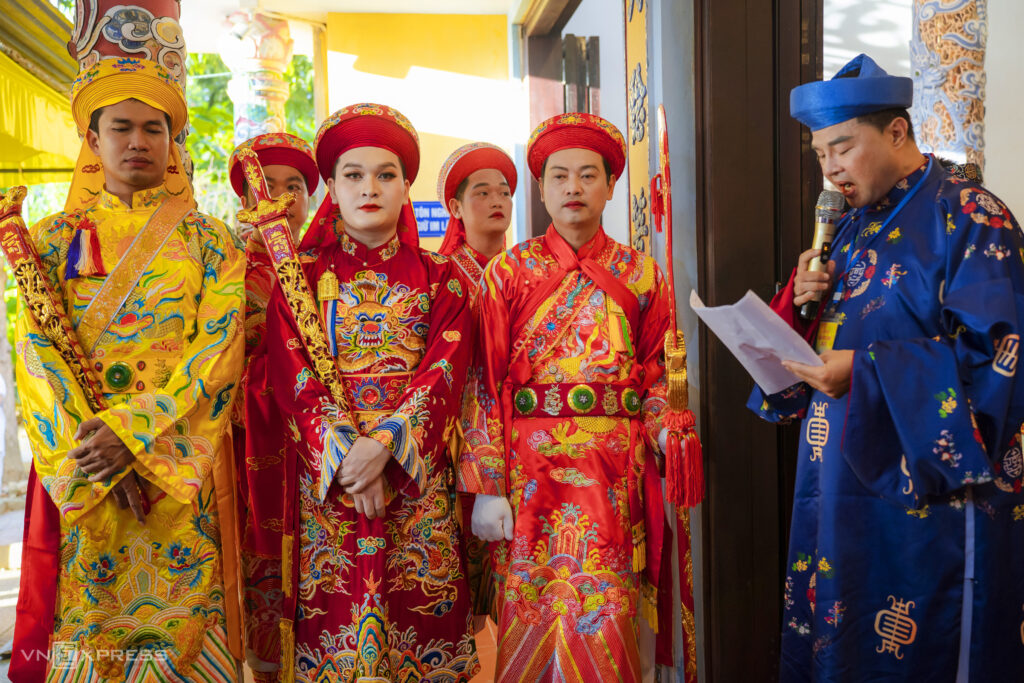
It is a complex and diverse system of beliefs and practices that is centered around the worship of the Mother Goddesses of the three realms: heaven, water, mountains and forests.
The Mother Goddesses are seen as the creators and protectors of the universe, and they are revered for their power, compassion, and wisdom. The practices related to their worship include prayers, rituals, offerings, and festivals.
One of the most important practices is “len dong”, or spirit possession ritual. This ritual is performed by mediums who are possessed by the spirits of the Mother Goddesses. The mediums then deliver messages from the goddesses to the community, and they also provide guidance and healing.
Another important practice is the worship of the Mother Goddesses at temples and shrines. These temples and shrines are often located in beautiful natural settings, such as mountains, rivers, and forests. Visitors to these temples and shrines come to pray for blessings, seek guidance, and give thanks to the Mother Goddesses.
History
The Vietnamese belief in worshiping the Mother Goddess of the Three Palaces is a mixture of indigenous Vietnamese religion and some elements of imported religions such as Taoism and Buddhism.
Since the 16th century, the practice of this belief has become a cultural activity with a profound influence on the social life and consciousness of the Vietnamese people.

The Practices related to Viet beliefs in the Mother Goddesses of Three Realms have a long and rich history, dating back to the pre-Buddhist era. The Mother Goddesses were worshiped by the ancient Vietnamese people as the creators and protectors of the universe.
The worship of the Mother Goddesses was particularly popular in the northern region of Vietnam, where they were known as the Three Realms Mothers (Tam Thanh Mot Me).
The worship of the Mother Goddesses continued to be popular during the Buddhist era, and it was eventually incorporated into Buddhism. The Mother Goddesses were identified with various Buddhist bodhisattvas, such as Avalokiteshvara (the Bodhisattva of Compassion) and Guan Yin (the Bodhisattva of Mercy).
In the 17th century, the worship of the Mother Goddesses experienced a revival in Vietnam. This revival was led by a charismatic medium named Le Thi Ngoc Han, who was known as the Mother Goddess of Phu Day. Le Thi Ngoc Han was believed to be possessed by the spirits of the Mother Goddesses, and she delivered messages from the goddesses to the community.
The Practices related to Viet beliefs in the Mother Goddesses of Three Realms continued to be popular throughout the 18th and 19th centuries. In the early 20th century, the practices were suppressed by the French colonial government. However, they survived in secret, and they experienced a resurgence after Vietnam gained independence in 1945.
Today, the Practices related to Viet beliefs in the Mother Goddesses of Three Realms are practiced by millions of people in Vietnam. The practices are a living tradition that continues to play an important role in the cultural and spiritual lives of many Vietnamese people.
Unique features

– One of the most unique features of the Practices related to Viet beliefs in the Mother Goddesses of Three Realms is the emphasis on the role of women as mediums and spirit healers. In many other religious and spiritual traditions, women are marginalized or excluded from positions of authority. However, in the Practices related to Viet beliefs in the Mother Goddesses of Three Realms, women play a central role.
– Mediums, who are typically women, are believed to be able to channel the spirits of the Mother Goddesses. They use their abilities to heal the sick, guide those in need, and deliver messages from the goddesses to the community.
– Another unique feature of the Practices related to Viet beliefs in the Mother Goddesses of Three Realms is the emphasis on the interconnectedness of all things. The Mother Goddesses are seen as the creators and protectors of all life, and they are worshiped for their compassion and wisdom. The practices related to their worship teach us to respect all living things and to live in harmony with the natural world.
– Finally, the Practices related to Viet belief in the Mother Goddesses of Three Realms are unique in their diversity and flexibility. The practices have evolved to incorporate elements of different religions and spiritual traditions. This diversity and flexibility have allowed the practices to remain relevant and meaningful to people from all walks of life.
Value of art

This is an important contribution to creating a spiritual bond linking heritage-practicing communities, promoting tolerance between ethnicities and religions, being compatible with international human rights regulations, and having no limits on practice. The belief in worshiping the Mother Goddess of the Three Palaces is a spiritual activity, where artistic elements such as costumes, dance, and music play an important role.
Every year, in the third and seventh months of the lunar calendar, religious activities to worship the Mother Goddess are solemnly held at Hon Chen Palace and have become a unique cultural festival of Thua Thien Hue. More than just a folk belief, hau dong is a unique traditional art form, combining many elements, such as music, performance, lyrics, and costumes. The people who stand on the bronze altar are collectively called bronze, recreating the images of saints who came to earth and are close to people’s lives.
Conclusion
On December 1, 2016, at the 11th session of the Intergovernmental Committee for Safeguarding of the Intangible Cultural Heritage of UNESCO held in Addis Ababa Capital, Ethiopia, the Practices related to the Viet Beliefs in the Mother Goddesses of Three Realms were officially recognized as Intangible Cultural Heritage of Humanity.
This demonstrates the perseverance and efforts of the whole community in preserving the nation’s intangible cultural heritage.
Get an opportunity to visit Intangible World Cultural Heritage in Vietnam through Vietnam E-Visa!